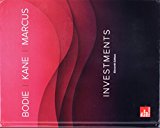
Investments, 11th Edition (exclude Access Card)
11th Edition
ISBN: 9781260201543
Author: Zvi Bodie Professor; Alex Kane; Alan J. Marcus Professor
Publisher: McGraw-Hill Education
expand_more
expand_more
format_list_bulleted
Concept explainers
Question
Chapter 16, Problem 13CP
A
Summary Introduction
To select: Bonds according to the economic recovery and economic recession.
Introduction : In economic survey the prices are decreased, thus value of callable bond is decreased. In economic recession the prices raised and value of callable bond is increased.
B
Summary Introduction
To calculate: The change in the price for bond ‘B’.
Introduction: The price change of bond ‘B’ is a product of the time period to the yield change of the bond. Here the change in YTM is 75 basis points.
C.
Summary Introduction
To explain: Short comes to analyze the bond ‘A’.
Introduction: Callable bonds also known as redeemable bonds which allows the investor to redeem its bond before its maturity date. When market goes down investor can refinance the debt.
Expert Solution & Answer
Want to see the full answer?
Check out a sample textbook solution
Students have asked these similar questions
Finance problem solve
Need answer for this.
Need asst. pls
Chapter 16 Solutions
Investments, 11th Edition (exclude Access Card)
Ch. 16 - Prob. 1PSCh. 16 - Prob. 2PSCh. 16 - Prob. 3PSCh. 16 - Prob. 4PSCh. 16 - Prob. 5PSCh. 16 - Prob. 6PSCh. 16 - Prob. 7PSCh. 16 - Prob. 8PSCh. 16 - Prob. 9PSCh. 16 - Prob. 10PS
Ch. 16 - Prob. 11PSCh. 16 - Prob. 12PSCh. 16 - Prob. 13PSCh. 16 - Prob. 14PSCh. 16 - Prob. 15PSCh. 16 - Prob. 16PSCh. 16 - Prob. 17PSCh. 16 - Prob. 18PSCh. 16 - Prob. 19PSCh. 16 - Prob. 20PSCh. 16 - Prob. 21PSCh. 16 - Prob. 22PSCh. 16 - Prob. 23PSCh. 16 - Prob. 24PSCh. 16 - Prob. 25PSCh. 16 - Prob. 1CPCh. 16 - Prob. 2CPCh. 16 - Prob. 3CPCh. 16 - Prob. 4CPCh. 16 - Prob. 5CPCh. 16 - Prob. 6CPCh. 16 - Prob. 7CPCh. 16 - Prob. 8CPCh. 16 - Prob. 9CPCh. 16 - Prob. 10CPCh. 16 - Prob. 11CPCh. 16 - Prob. 12CPCh. 16 - Prob. 13CP
Knowledge Booster
Learn more about
Need a deep-dive on the concept behind this application? Look no further. Learn more about this topic, finance and related others by exploring similar questions and additional content below.Similar questions
arrow_back_ios
SEE MORE QUESTIONS
arrow_forward_ios
Recommended textbooks for you
 Intermediate Financial Management (MindTap Course...FinanceISBN:9781337395083Author:Eugene F. Brigham, Phillip R. DavesPublisher:Cengage Learning
Intermediate Financial Management (MindTap Course...FinanceISBN:9781337395083Author:Eugene F. Brigham, Phillip R. DavesPublisher:Cengage Learning

Intermediate Financial Management (MindTap Course...
Finance
ISBN:9781337395083
Author:Eugene F. Brigham, Phillip R. Daves
Publisher:Cengage Learning
Bond Valuation - A Quick Review; Author: Pat Obi;https://www.youtube.com/watch?v=xDWTPmqcWW4;License: Standard Youtube License